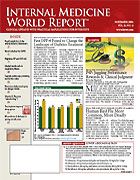The New Thinking on HIV Screening%u2014More Is Better
The New Thinking on HIV Screening—More Is Better
By Rebekah McCallister
The question of who should be tested for HIV infection has taken a new turn with the recent publication of 2 studies showing many benefits associated with routine screening for HIV infection, which differs from current recommendations of the Centers for Disease Control and Prevention (CDC) that call for limiting routine counseling, testing, and referral in communities with a ≥1% prevalence of HIV.
In the first study (N Engl J Med. 2005;352:570-585) Gillian D. Sanders, PhD, of Duke Clinical Research Institute, Duke University, Durham, NC, and colleagues compared the costs, quality of life, and survival associated with routine HIV screening programs and those associated with current practices based on current CDC recommendations. Results showed that screening increased life expectancy by 5.48 days at an estimated cost of $194 per patient, which resulted in a cost-effectiveness ratio of $15,078 per quality adjusted life-year.
The authors outline many compelling reasons to expand HIV screening programs, including that a delayed diagnosis of HIV infection can result in irrevocable damage to the immune system; transmission of the deadly infection to others; and that a delay of highly active antiretroviral therapy (HAART) may lead to the development of drug resistance and increase infectivity.
In this case-based analysis, the 1.52 years extended life-expectancy benefit that was evident with early identification followed by a HAART regimen, decreased in patients whose infection was identified late. “This substantial survival advantage is the reason that screening reaches conventional levels of cost-effectiveness even when we did not consider the additional benefit from reduced transmission to sexual partners,” Dr Sanders and colleagues wrote.
When changes in risk behavior associated with counseling as well as the decline in viral load during HAART therapy were accounted for, the rates of transmission fell by about 20% with screening as compared to no screening.
This “strongly indicates that current approaches to testing are inadequate,” the authors pointed out.
In the second study (N Engl J Med. 2005;352:586-595), A. David Paltiel, PhD, of the Department of Epidemiology and Public Health, Yale School of Medicine, New Haven, Conn, and colleagues also compared routine, voluntary screening with current practices in 3 specific populations: high-risk (3.0% prevalence of undiagnosed HIV infection), CDC threshold (1.0% and 0.12%, respectively), and US general (0.1% and 0.01%).
“In all but the lowest-risk populations, voluntary screening for HIV once every 3 to 5 years is justified on both clinical and cost-effectiveness grounds,” the authors wrote. Notably, among the highest-risk population, current screening practices resulted in 29% of patients with HIV infection being unaware of their disease status until their first opportunistic infection (table).
Based on the current testing recommendations, about 44,000 to 60,000 secondary transmissions of HIV infection could be expected per 100,000 participants in the screening program. “A single ELISA [enzyme-linked immunosorbent assay] could avert up to 300 of these secondary transmission,” they wrote. “Repeated testing every 5, 3, and 1 years could avert 2700, 3600, and 5100 infections, respectively.”
Table. Percentage differences with varying ELISA testing scenarios in high-risk populations
Means of HIV detection
Current practice (%)
Current practice/single ELISA (%)
Current practice/ELISA every 5 years (%)
Current practice/ELISA every 3 years (%)
Current practice/annual ELISA (%)
Background testing
63
61
44
36
19
Screening program
0
3
34
47
73
Opportunistic infection
29
27
16
12
6
Never detected*
8
8
5
4
2
*“Never detected” referred to those who were not tested before death or if tested, never received test results.
ELISA = enzyme-linked immunosorbent assay.
Adapted from theN Engl J Med. 2005;352:590.
